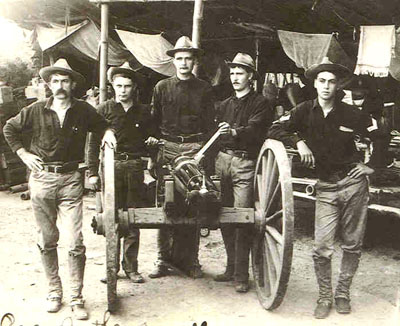

General:
The Gatling gun, one of the earliest forms of functional machines
guns, was used during the Spanish American War, both on land and at sea.
The use of the Gatling gun during the War is most well-known from its
use in the assault on San Juan Hill.
The basic idea of the gun is that there are series of barrels, generally ten, which revolve inside of a supporting frame. As the barrels revolve, a mechanism automatically inserts rounds being fed from a vertical magazine mounted atop the gun. As the barrels continue to revolve, each barrel is cocked, fired and the shell casing removed in one single revolution. The barrels are revolved through the use of a crank mounted on the weapon.
The Gatling gun went through a series of improvements, with the Model 1895 being the model used by the U.S. Army in the Spanish American War. The Army purchased eighteen of these guns on May 20, 1898. Thirty-one more were delivered to the Army, just over two weeks after the war ended.
The Gatling Gun Detachment of General Shafter'sVth Corps in Cuba was commanded by Lt. John Henry Parker. His detachment was an ad hoc group. His men were not adequately armed. No spare parts or tools for repair were provided to them. The men who formed the detachment were not even given adequate training, and received their training while serving on the skirmish line.
The most famous use of the Gatling gun was at San Juan Hill. Here, as
the infantry ascended San Juan Hill, "a peculiar drumming noise was
heard." Some thought it was Spanish machine guns. Theodore
Roosevelt, on the adjacent Kettle Hill, yelled to his men "Its the
Gatlings, men, our Gatlings!". He was right, Parker's
Gatling's were in use. Parker himself later recorded the following
account of the event:
"The guns were pushed right up in the hottest place there was in the battle-field...and put into action at the most critical point of the battle... [the guns] so successfully subdued the Spanish fire that from that time to the capture of the practically impregnable position was only eight-and-one-half minutes. The expenditure of ammunition durin this time, in which a continuous fire was kept up from three guns, was 6,000 rounds per gun..."This action represented the first time that the U.S. Army used close-support machine guns in an attack against an enemy position. The event would have rammifications for years to come.

The tremendous fire power of the Gatling gun was undeniable, and did come into play at a very crucial moment during the San Juan Hill assaults.
| Total Weight (with tools): | 594 pounds | |
|---|---|---|
| Range: | 1000 yards |
| Caliber: | .30 caliber | |
|---|---|---|
| Bullet weight: | 220 grains | |
| Muzzle velocity: | 2,000 feet per second |
Cohen, Stan. Images of Spanish American War, April-August,1998. (Missoula:Pictorial Histories Publishing Co., Inc., 1997).
Crabtree, J. B., The Passing of Spain and the Ascendency of America. (Springfield, MA: The King-Richardson Publishing Co., 1898). 396-397
Krausz, John (Editor), "The Gatling Gun", reprinted from Great Industries of the United States, 1873 in How to Buy an Elephant. (New York: Hawthorn Books, 1977) 138-139.
Murphy, Paul - Photo of the gatling gun in the Philippines.
Young, James Rankin, History of Our War with Spain. (Washington DC: J. R. Jones, 1898), Opposite p. 228 (image of gatling gun drill).